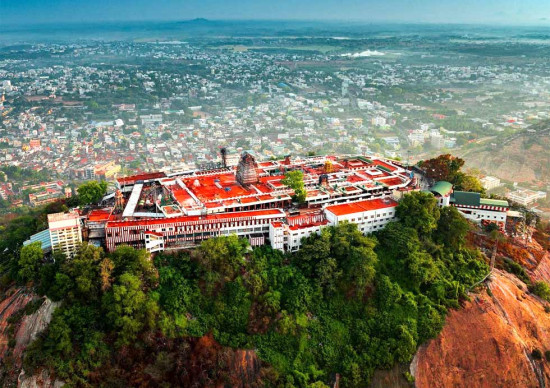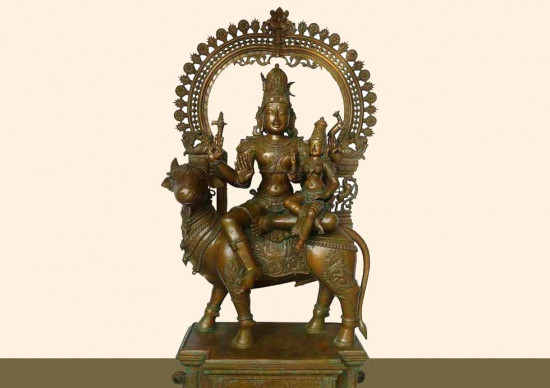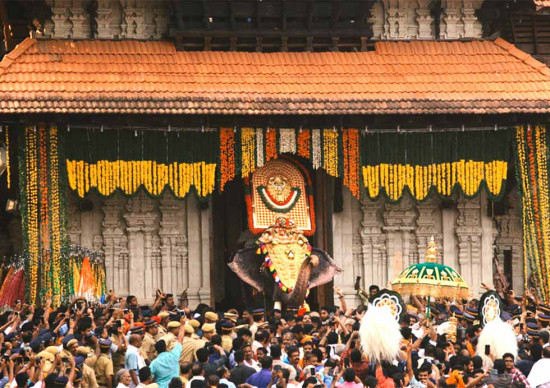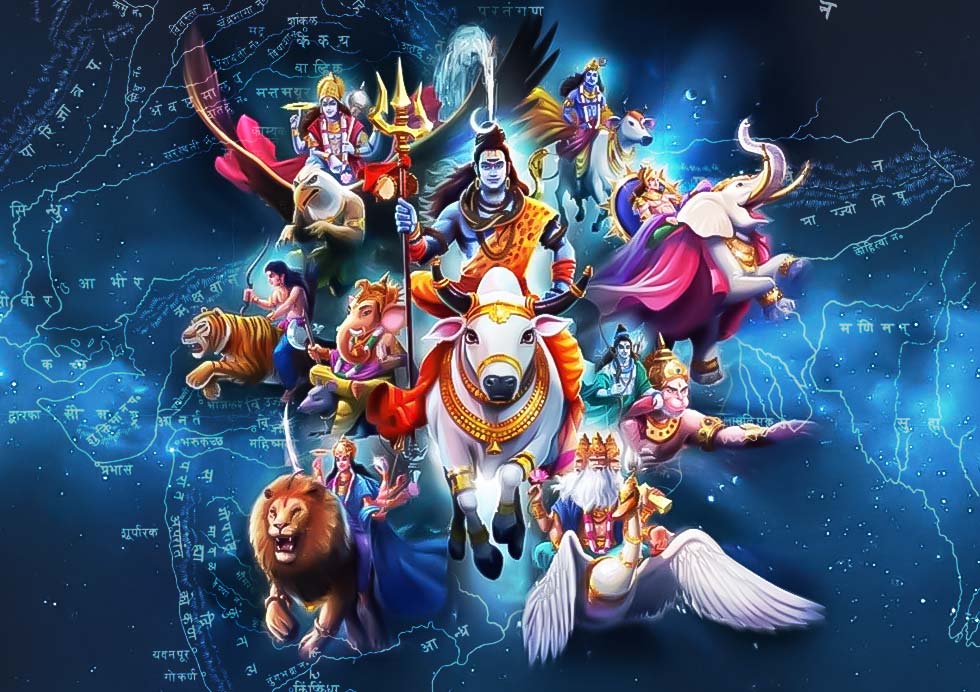
India is a land of diverse cultures, languages, and religions. The Indian pantheon of gods and goddesses is vast and varied. Each deity is associated with specific attributes and characteristics that have a significant impact on people’s lives. Hinduism is the dominant religion in India, and most of the gods and goddesses belong to this religion. In this article, we will delve into the symbolism behind Indian gods and goddesses.

Lord Shiva - Mahadeva
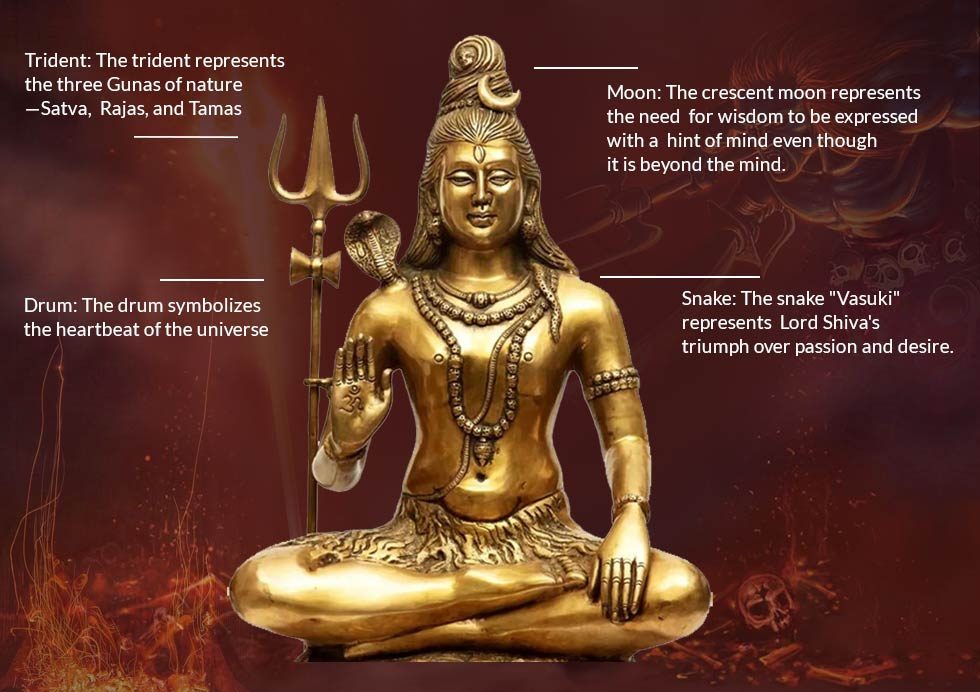
Lord Shiva is one of the most revered deities in India, known as the god of destruction. His iconic image often depicts him holding a trident and a drum, symbolizing the continuous cycle of birth, death, and rebirth. The trident represents the three Gunas of nature, while the drum represents the universe’s heartbeat.
Additionally, Lord Shiva is depicted with three eyes, with the third eye representing wisdom and the ability to see beyond the physical world. The Ganga flowing from his head represents knowledge, and the crescent moon symbolizes expressing wisdom with a hint of mind.
Lord Shiva wears a tiger skin, representing victory over animal instincts, and holds a rosary of Rudraksha, symbolizing grace and meditation. A snake named Vasuki coiled around his neck represents his conquest over passion and desires. Finally, his vehicle, the bull Nandi, represents dharma.
When employees feel that their workplace values creativity and aesthetics, they are more likely to feel invested in their work and committed to the success of the business. This can lead to a more positive workplace culture, better collaboration and better teamwork.
Additionally, Lord Shiva is depicted with three eyes, with the third eye representing wisdom and the ability to see beyond the physical world. The Ganga flowing from his head represents knowledge, and the crescent moon symbolizes expressing wisdom with a hint of mind.
Lord Shiva wears a tiger skin, representing victory over animal instincts, and holds a rosary of Rudraksha, symbolizing grace and meditation. A snake named Vasuki coiled around his neck represents his conquest over passion and desires. Finally, his vehicle, the bull Nandi, represents dharma.
When employees feel that their workplace values creativity and aesthetics, they are more likely to feel invested in their work and committed to the success of the business. This can lead to a more positive workplace culture, better collaboration and better teamwork.
Goddess Kali - Mahakali
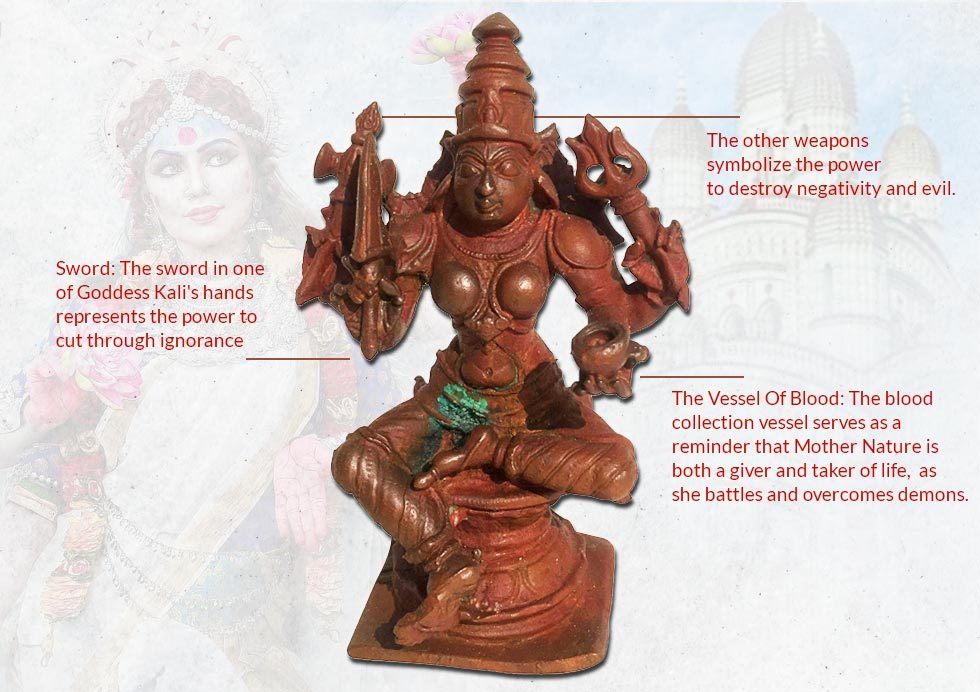
Goddess Kali is a prominent deity in Hinduism and is known for her fearsome appearance. She is often depicted with a fierce expression, a protruding tongue, and four arms, holding a sword, a severed head, and two other weapons.
However, behind her fierce exterior lies a deeper spiritual meaning. Goddess Kali’s symbolism represents the destruction of ego and the realization of the ultimate truth. The sword in one of her hands represents the power to cut through ignorance, while the other weapons symbolize the power to destroy negativity and evil.
The severed head that Goddess Kali holds represents the ego or the false sense of self that needs to be destroyed for spiritual growth. Kali’s fearsome appearance and actions represent her ability to destroy illusions and attachments that keep us from realizing our true nature. Her protruding tongue symbolizes her insatiable hunger for truth and her thirst for the nectar of knowledge. The blood collection vessel serves as a reminder that Mother Nature is both a giver and taker of life, as she battles and overcomes demons.
In Hinduism, Kali is seen as a powerful force that can bring about transformation and change. She is worshiped by those seeking to overcome their ego and negative tendencies and achieve spiritual liberation. Her symbolism teaches us that in order to reach spiritual enlightenment, we must be willing to confront our inner demons and let go of attachments and illusions.
However, behind her fierce exterior lies a deeper spiritual meaning. Goddess Kali’s symbolism represents the destruction of ego and the realization of the ultimate truth. The sword in one of her hands represents the power to cut through ignorance, while the other weapons symbolize the power to destroy negativity and evil.
The severed head that Goddess Kali holds represents the ego or the false sense of self that needs to be destroyed for spiritual growth. Kali’s fearsome appearance and actions represent her ability to destroy illusions and attachments that keep us from realizing our true nature. Her protruding tongue symbolizes her insatiable hunger for truth and her thirst for the nectar of knowledge. The blood collection vessel serves as a reminder that Mother Nature is both a giver and taker of life, as she battles and overcomes demons.
In Hinduism, Kali is seen as a powerful force that can bring about transformation and change. She is worshiped by those seeking to overcome their ego and negative tendencies and achieve spiritual liberation. Her symbolism teaches us that in order to reach spiritual enlightenment, we must be willing to confront our inner demons and let go of attachments and illusions.
Lord Ganesha - The Remover of Obstacles
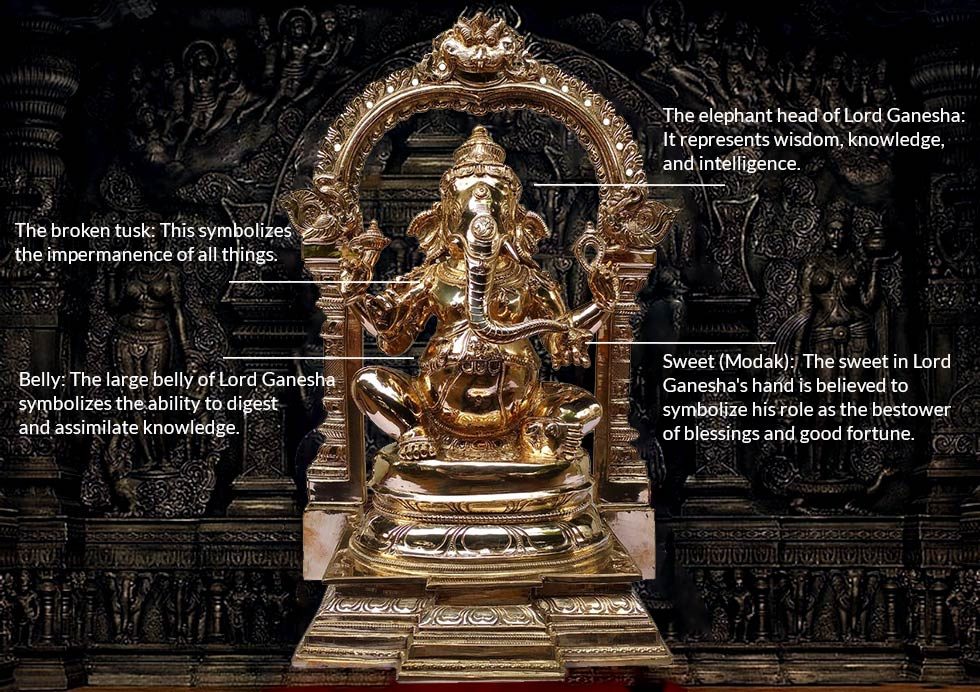
Lord Ganesha is one of the most beloved and worshiped deities in India. He is often depicted with an elephant head and a human body, with a large belly and four arms. Lord Ganesha’s symbolism represents the power to remove obstacles, and he is worshiped before starting any new venture or endeavor.
The elephant head of Lord Ganesha represents wisdom, knowledge, and intelligence. Elephants are known for their sharp memories, and Lord Ganesha’s elephant head is a reminder to his devotees to be mindful and wise in their actions. The large belly of Lord Ganesha symbolizes the ability to digest and assimilate knowledge. It represents the importance of taking in knowledge and experiences, processing them, and using them to grow and evolve.
Lord Ganesha’s four arms are also symbolic. One hand holds his broken tusk, representing purity and enlightenment. Another hand holds an ax, symbolizing the cutting of attachments and negative tendencies. A third hand holds a bowl of sweets, representing the sweetness of life and the rewards of hard work. The fourth hand is raised in a gesture of blessing and protection, symbolizing Lord Ganesha’s role as the remover of obstacles.
In Hinduism, Lord Ganesha is revered as a powerful deity who can help his devotees overcome obstacles and achieve success. His symbolism teaches us the importance of wisdom, knowledge, and hard work in our lives, and the necessity of removing negative tendencies and attachments that may hinder our growth. Overall, Lord Ganesha’s symbolism represents the power to overcome obstacles, wisdom, and the importance of hard work and perseverance in achieving success.
The elephant head of Lord Ganesha represents wisdom, knowledge, and intelligence. Elephants are known for their sharp memories, and Lord Ganesha’s elephant head is a reminder to his devotees to be mindful and wise in their actions. The large belly of Lord Ganesha symbolizes the ability to digest and assimilate knowledge. It represents the importance of taking in knowledge and experiences, processing them, and using them to grow and evolve.
Lord Ganesha’s four arms are also symbolic. One hand holds his broken tusk, representing purity and enlightenment. Another hand holds an ax, symbolizing the cutting of attachments and negative tendencies. A third hand holds a bowl of sweets, representing the sweetness of life and the rewards of hard work. The fourth hand is raised in a gesture of blessing and protection, symbolizing Lord Ganesha’s role as the remover of obstacles.
In Hinduism, Lord Ganesha is revered as a powerful deity who can help his devotees overcome obstacles and achieve success. His symbolism teaches us the importance of wisdom, knowledge, and hard work in our lives, and the necessity of removing negative tendencies and attachments that may hinder our growth. Overall, Lord Ganesha’s symbolism represents the power to overcome obstacles, wisdom, and the importance of hard work and perseverance in achieving success.
Goddess Lakshmi - The Goddess of Wealth
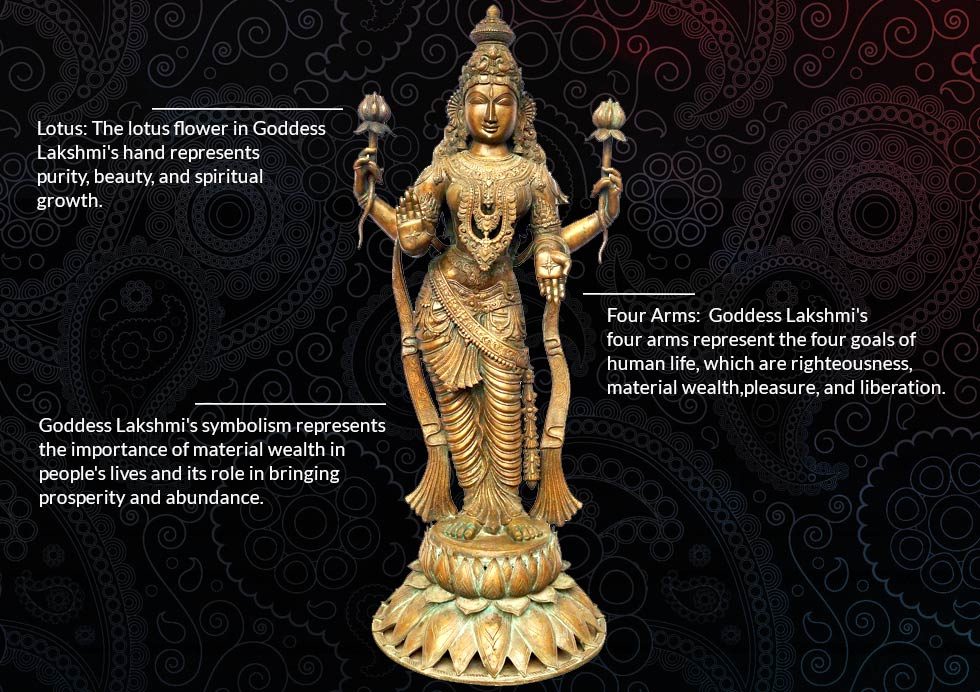
Goddess Lakshmi is a prominent deity in Hinduism, known as the goddess of wealth, prosperity, and abundance. She is often depicted with four arms, holding a lotus flower, a pot of gold, and two other objects.
The lotus flower in Goddess Lakshmi’s hand represents purity, beauty, and spiritual growth. The lotus is considered a sacred flower in Hinduism, and its symbolism teaches us that just as a lotus grows out of muddy water and blossoms into a beautiful flower, we too can grow and overcome life’s challenges.
The pot of gold in Goddess Lakshmi’s other hand symbolizes abundance, prosperity, and material wealth. However, Lakshmi’s symbolism is not limited to material wealth alone. It also represents inner wealth, such as spiritual knowledge, love, and compassion.
Goddess Lakshmi’s four arms represent the four goals of human life in Hinduism, which are dharma (righteousness), artha (material wealth), kama (pleasure), and moksha (liberation). Lakshmi’s symbolism teaches us that material wealth is essential for a comfortable and fulfilling life, but it should not be our sole focus. It should be balanced with spiritual growth and righteous living.
Overall, Goddess Lakshmi’s symbolism represents the importance of material wealth in people’s lives and its role in bringing prosperity and abundance. However, it also teaches us that true abundance and fulfillment come from inner wealth and spiritual growth.
The lotus flower in Goddess Lakshmi’s hand represents purity, beauty, and spiritual growth. The lotus is considered a sacred flower in Hinduism, and its symbolism teaches us that just as a lotus grows out of muddy water and blossoms into a beautiful flower, we too can grow and overcome life’s challenges.
The pot of gold in Goddess Lakshmi’s other hand symbolizes abundance, prosperity, and material wealth. However, Lakshmi’s symbolism is not limited to material wealth alone. It also represents inner wealth, such as spiritual knowledge, love, and compassion.
Goddess Lakshmi’s four arms represent the four goals of human life in Hinduism, which are dharma (righteousness), artha (material wealth), kama (pleasure), and moksha (liberation). Lakshmi’s symbolism teaches us that material wealth is essential for a comfortable and fulfilling life, but it should not be our sole focus. It should be balanced with spiritual growth and righteous living.
Overall, Goddess Lakshmi’s symbolism represents the importance of material wealth in people’s lives and its role in bringing prosperity and abundance. However, it also teaches us that true abundance and fulfillment come from inner wealth and spiritual growth.
Lord Vishnu - The Preserver
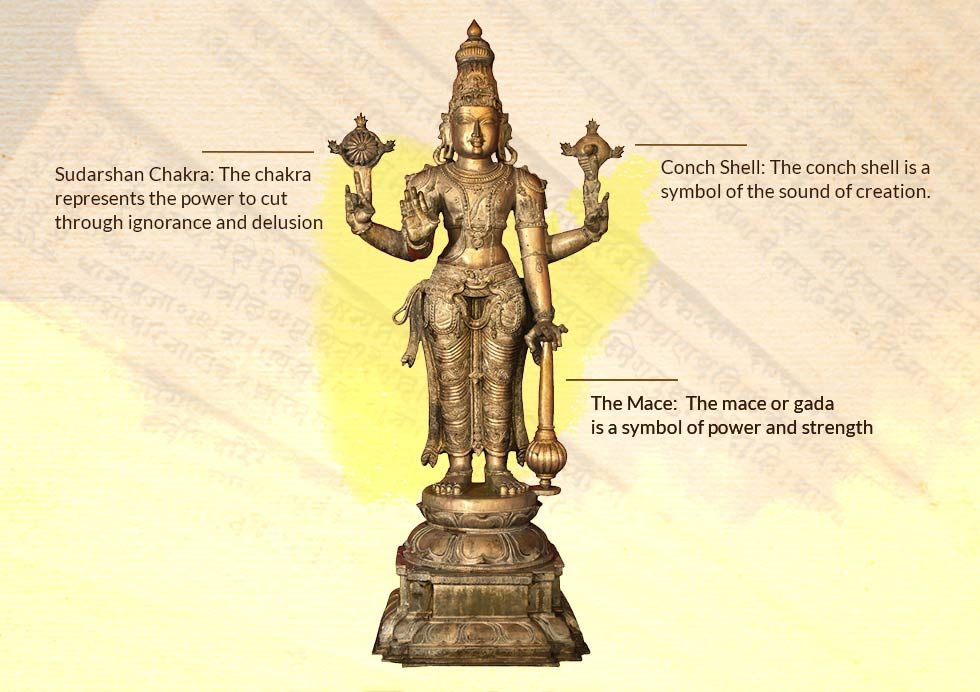
Lord Vishnu is one of the most important deities in Hinduism, and he is revered as the preserver and sustainer of the universe. He is part of the Hindu trinity, which also includes Lord Brahma (the creator) and Lord Shiva (the destroyer). Lord Vishnu is often depicted with four arms, each holding a specific object that symbolizes his divine qualities and powers.
The first object held by Lord Vishnu is the conch shell, which is a symbol of the sound of creation. According to Hindu mythology, Lord Vishnu used his conch shell to create the primordial sound that gave rise to the universe. The conch shell is also used in Hindu rituals as a sacred instrument to invoke the presence of the divine.
The second object held by Lord Vishnu is the discus or chakra, which represents the power to cut through ignorance and delusion. The discus is said to be a powerful weapon that Lord Vishnu used to destroy evil and protect his devotees. It also symbolizes the cyclical nature of time and the eternal rhythm of the universe.
The third object held by Lord Vishnu is the mace or gada, which is a symbol of power and strength. The mace is often used as a weapon in Hindu mythology, and it represents Lord Vishnu’s ability to protect and defend his devotees against all kinds of threats and dangers.
The fourth and final object held by Lord Vishnu is the lotus flower, which represents purity and spiritual enlightenment. The lotus flower is often used in Hindu iconography to symbolize the awakening of the soul and the attainment of spiritual liberation. Lord Vishnu’s holding of the lotus flower in his hand represents his role as a guide and mentor to his devotees on their spiritual journey.
The first object held by Lord Vishnu is the conch shell, which is a symbol of the sound of creation. According to Hindu mythology, Lord Vishnu used his conch shell to create the primordial sound that gave rise to the universe. The conch shell is also used in Hindu rituals as a sacred instrument to invoke the presence of the divine.
The second object held by Lord Vishnu is the discus or chakra, which represents the power to cut through ignorance and delusion. The discus is said to be a powerful weapon that Lord Vishnu used to destroy evil and protect his devotees. It also symbolizes the cyclical nature of time and the eternal rhythm of the universe.
The third object held by Lord Vishnu is the mace or gada, which is a symbol of power and strength. The mace is often used as a weapon in Hindu mythology, and it represents Lord Vishnu’s ability to protect and defend his devotees against all kinds of threats and dangers.
The fourth and final object held by Lord Vishnu is the lotus flower, which represents purity and spiritual enlightenment. The lotus flower is often used in Hindu iconography to symbolize the awakening of the soul and the attainment of spiritual liberation. Lord Vishnu’s holding of the lotus flower in his hand represents his role as a guide and mentor to his devotees on their spiritual journey.
Goddess Durga - The Divine Mother
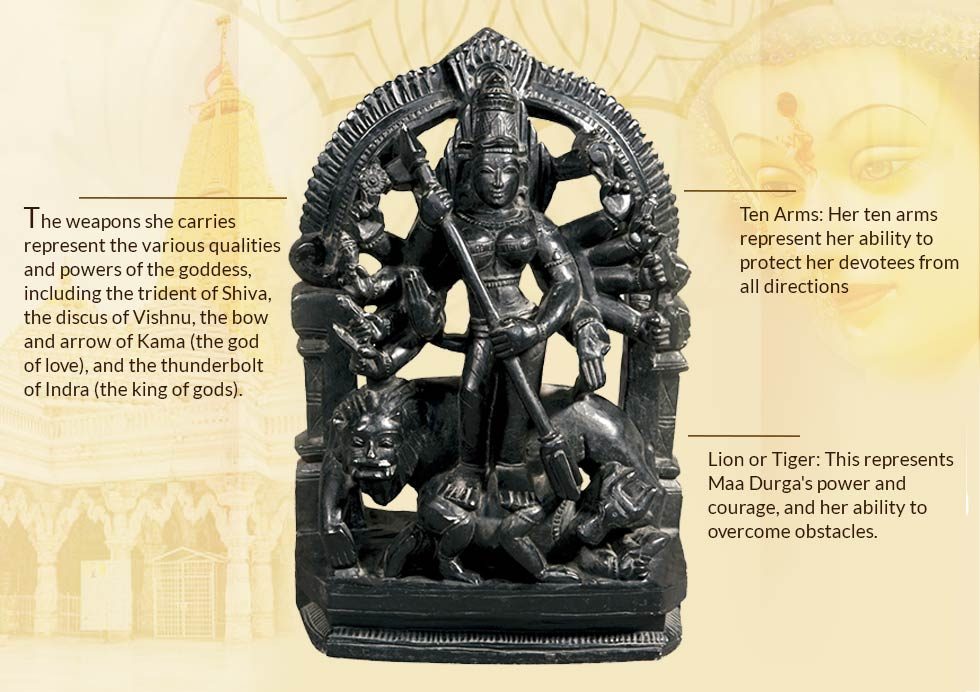
Goddess Durga is one of the most revered and worshiped deities in Hindu mythology. She is believed to be a form of the divine mother or Shakti, the primordial energy that is the source of all creation. According to Hindu scriptures, the goddess Durga was created by the combined energies of various gods, including Brahma, Vishnu, and Shiva, to defeat the demon Mahishasura, who had become invincible through a boon from Lord Brahma.
In Hindu iconography, Goddess Durga is depicted with ten arms, each holding a different weapon. These weapons represent the various qualities and powers of the goddess, including the trident of Shiva, the discus of Vishnu, the bow and arrow of Kama (the god of love), and the thunderbolt of Indra (the king of gods). The goddess is also depicted riding a lion or tiger, which represents her power and courage, as well as her ability to overcome obstacles.
The symbolism of Goddess Durga is significant, as it represents the power to overcome obstacles and the victory of good over evil. Her ten arms represent her ability to protect her devotees from all directions, and her fierce and protective aspect is seen as a representation of the strength and resilience of the feminine. The lion or tiger she rides represents her fearlessness and the control she has over her instincts and emotions.
During the festival of Navratri, which is celebrated over nine nights in honor of the goddess Durga, devotees worship her and seek her blessings for prosperity, success, and protection. It is believed that invoking the goddess during this period can help one overcome all obstacles and achieve their goals.
In Hindu iconography, Goddess Durga is depicted with ten arms, each holding a different weapon. These weapons represent the various qualities and powers of the goddess, including the trident of Shiva, the discus of Vishnu, the bow and arrow of Kama (the god of love), and the thunderbolt of Indra (the king of gods). The goddess is also depicted riding a lion or tiger, which represents her power and courage, as well as her ability to overcome obstacles.
The symbolism of Goddess Durga is significant, as it represents the power to overcome obstacles and the victory of good over evil. Her ten arms represent her ability to protect her devotees from all directions, and her fierce and protective aspect is seen as a representation of the strength and resilience of the feminine. The lion or tiger she rides represents her fearlessness and the control she has over her instincts and emotions.
During the festival of Navratri, which is celebrated over nine nights in honor of the goddess Durga, devotees worship her and seek her blessings for prosperity, success, and protection. It is believed that invoking the goddess during this period can help one overcome all obstacles and achieve their goals.
Goddess Saraswati - Goddess of Wisdom
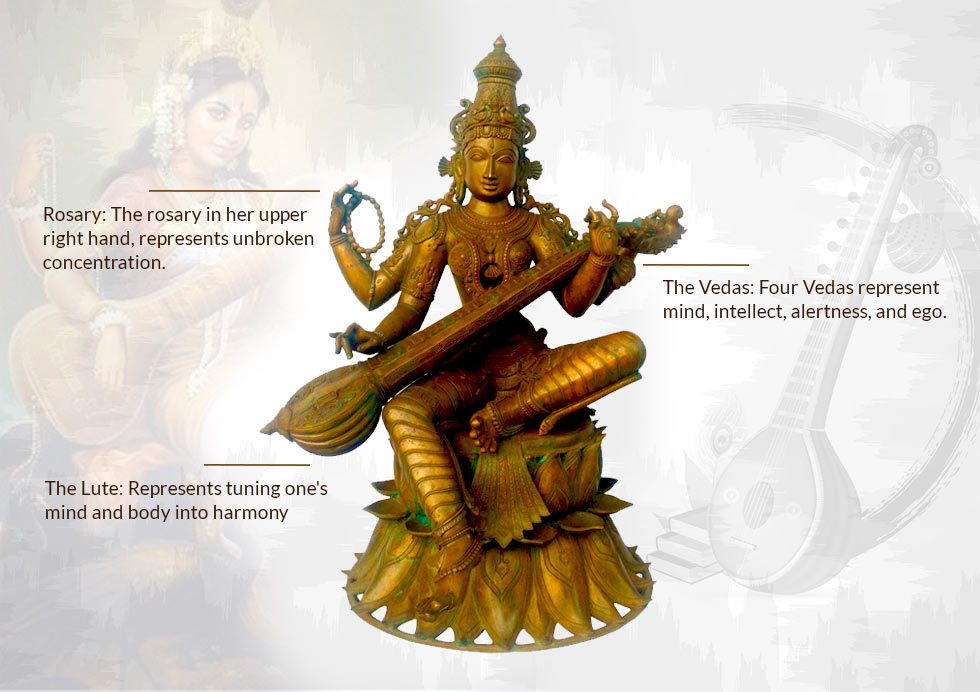
Saraswati is the goddess of wisdom, music, and art, as well as the patron deity of speech. She is also known as Vani because she is the personification of speech. She is the consort of Brahma, the Hindu god of creation, and inspires him to create the worlds with their beings. She is ensconced in Vedic mantras. The seven notes of Indian classical music are said to have come from her lute’s strings.
She is depicted four-armed and seated on a lotus pedestal. She holds a rosary in her upper right hand, which represents unbroken concentration. Her upper left hand holds the Vedas, which represent mind, intellect, alertness, and ego. He is seen playing a lute with her lower hands, which represent tuning one’s mind and body into harmony; prayer beads represent spiritual knowledge. She is seated in a sukhasana (relaxed pose) wearing a white sari; her white sari represents simplicity and elegance.
In conclusion, the Indian pantheon of gods and goddesses is rich in symbolism and meaning. Each deity represents specific attributes and characteristics that have a profound impact on people’s lives. Understanding the symbolism behind these deities can help individuals gain a deeper appreciation for the diverse cultures and traditions of India.
She is depicted four-armed and seated on a lotus pedestal. She holds a rosary in her upper right hand, which represents unbroken concentration. Her upper left hand holds the Vedas, which represent mind, intellect, alertness, and ego. He is seen playing a lute with her lower hands, which represent tuning one’s mind and body into harmony; prayer beads represent spiritual knowledge. She is seated in a sukhasana (relaxed pose) wearing a white sari; her white sari represents simplicity and elegance.
In conclusion, the Indian pantheon of gods and goddesses is rich in symbolism and meaning. Each deity represents specific attributes and characteristics that have a profound impact on people’s lives. Understanding the symbolism behind these deities can help individuals gain a deeper appreciation for the diverse cultures and traditions of India.

